S T OR
Page 30
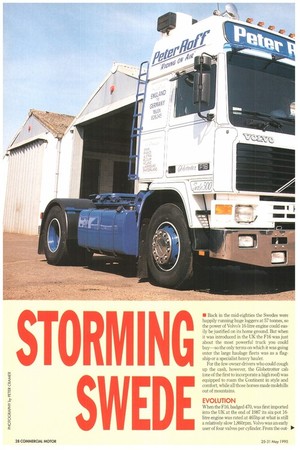
Page 31
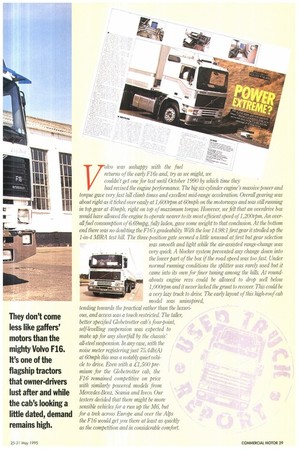
Page 32
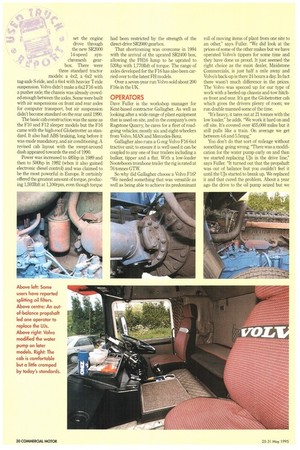
Page 33
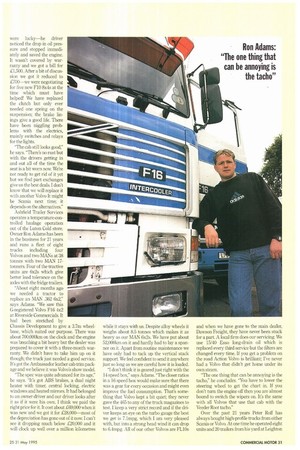
Page 34

Page 35
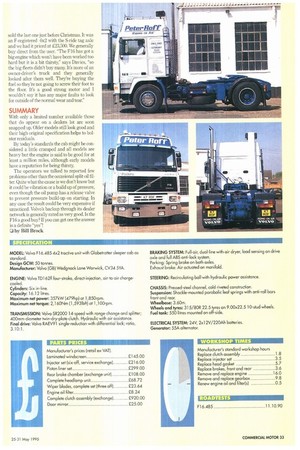
If you've noticed an error in this article please click here to report it so we can fix it.
MING EDE
• Back in the mid-eighties the Swedes were happily running huge loggers at 57 tonnes, so the power of Volvo's 16-litre engine could easily be justified on its home ground. But when it was introduced in the UK the F16 was just about the most powerful truck you could buy—so the only terms on which it was going
enter the rge haulage fleets was as a flagship or a specialist heavy hauler.
For the few owner-drivers who could cough up the cash, however, the Globetrotter cab (one of the first to incorporate a high roof) was equipped to roam the Continent in style and comfort, while all those horses made molehills out of mountains.
EVOLUTION
When the F16, badged 470, was first imported into the UK at the end of 1987 its six-pot 16litre engine was rated at 465hp at what is still a relatively slow 1,860rpm. Volvo was an early user of four valves per cylinder. From the out10. olvo was unhappy with the fuel returns of the early Fl 6s and, try as we might, we couldn't get one for test until October 1990 by which time they had revised the engine performance. The big six-cylinder engine's massive power and torque gave very fast hill climb times and excellent mid-range acceleration. Overall gearing was about right as it ticked over easily at 1,600rpm at 60mPh on the motorways and was still running in top gear at 40mph, right on top of maximum torque. However, we felt that an overdrive box would have allowed the engine to operate nearer to its most efficient speed of 1,200rpm. An overall fuel consumption of 6.69mpg, fully laden, gave some weight to that conclusion. At the bottom end there was no doubting the F16's gradeability. With the low 14.98:1 first gear it strolled up the 1-in-4 MIRA test hill. The three-position gate seemed a little unusual at first but gear selection was smooth and light while the air-assisted range-change was very quick. A blocker system prevented any change down into the lower part of the box if the road speed was too fast. Under normal running conditions the splitter was rarely used but it came into its own for finer tuning among the hills. At roundabouts engine revs could be allowed to drop well below 1,000rpm and it never lacked the grunt to recover This could be a very lazy truck to drive The early layout of this high-roof cab model was uninspired, tending towards the practical rather than the luxurious, and access was a touch restricted. The taller, better specified Globetrotter cab's four-point, self-levelling suspension was expected to make up for any shortfall by the chassis' all-steel suspension. In any case, with the noise meter registering just 75.4db(A) at 60mph this was a notably quiet vehicle to drive Even with a 11,500 premium for the Globetrotter cab, the F16 remained competitive on price with similarly powered models from Mercedes-Benz, Scania and Iveco. Our testers decided that there might be more sensible vehicles for a run up the M6, but for a trek across Europe and over the Alps the FI6 would get you there at least as quickly as the competition and in considerable comfort.
set the engine drove through the new SR2000 14-speed syn chromesh gear box. There were three standard tractor models: a 4x2, a 6x2 with tag-axle S-ride, and a 6x4 with heavier T-ride suspension. Volvo didn't make a 6x2 F16 with a pusher axle; the chassis was already crowded enough between the axles. Some were built with air suspensions on front and rear axles for computer transport, but air suspension didn't become standard on the rear until 1990.
The basic cab construction was the same as the F10 and F12 sleeper models but the F16 came with the high-roof Globetrotter as standard. It also had ABS braking, long before it was made mandatory, and air conditioning. A revised cab layout with the swept-around dash appeared towards the end of 1990.
Power was increased to 485hp in 1989 and then to 500hp in 1992 (when it also gained electronic diesel control) and was claimed to be the most powerful in Europe. It certainly offered the greatest amount of torque, producing 1,5931bft at 1,100rpm, even though torque had been restricted by the strength of the direct-drive SR21300 gearbox.
That shortcoming was overcome in 1994 with the arrival of the uprated SR2400 box, allowing the FH16 lump to be uprated to 520hp with 1,7701bft of torque. The range of axles developed for the F16 has also been carried over to the latest FH models.
Over a seven-year run Volvo sold about 200 F16s in the UK.
OPERATORS
Dave Fuller is the workshop manager for Kent-based contactor Gallagher. As well as looking after a wide range of plant equipment that is used on site, and in the company's own Ragstone Quarry, he cares for a fleet of roadgoing vehicles; mostly six and eight-wheelers from Volvo, MAN and Mercedes-Benz.
Gallagher also runs a G-reg Volvo F16 6x4 tractive unit; to ensure it is well used it can be coupled to any one of four trailers including a bulker, tipper and a flat. With a low-loader Nooteboom trombone trailer the rig is rated at 76 tonnes GTW.
So why did Gallagher choose a Volvo F16? "We needed something that was versatile as well as being able to achieve its predominant roll of moving items of plant from one site to an other," says Fuller. "We did look at the prices of some of the other makes but we have operated Volvo's tippers for some time and they have done us proud. It just seemed the right choice as the main dealer, Maidstone Commercials, is just half a mile away and Volvo's back-up is there 24 hours a day. In fact there wasn't much difference in the prices. The Volvo was specced up for our type of work with a beefed-up chassis and tow hitches front and rear. It's got the Globetrotter cab which gives the drivers plenty of room; we run double manned some of the time.
"It's heavy, it tares out at 21 tonnes with the low loader," he adds. "We work it hard on and off site. It's covered over 455,000 miles but it still pulls like a train. On average we get between 4.6 and 5.5mpg."
You don't do that sort of mileage without something going wrong. "There was a modification for the water pump early on and then we started replacing Ujs in the drive line," says Fuller. "It turned out that the propshaft was out of balance but you couldn't feel it until the [Zs started to break up. We replaced it and that cured the problem. About a year ago the drive to the oil pump seized but we were lucky—he driver noticed the drop in oil pressure and stopped immediately and saved the engine. It wasn't covered by warranty and we got a bill for £1,500. After a bit of discussion we got it reduced to £700—we were negotiating for five new F10 8x4s at the time which must have helped! We have replaced the clutch but only ever needed one spring on the suspension; the brake linings give a good life. There have been niggling problems with the electrics, mainly switches and relays for the lights.
"The cab still looks good," he says. "There's no rust but with the drivers getting in and out all of the time the seat is a bit worn now We're not ready to get rid of it yet but we find part exchanges give us the best deals. I don't know that we will replace it with another Volvo It might be Scania next time; it depends on the alternatives."
Ashfield Trailer Services operates a temperature-controlled haulage operation out of the Luton Cold store. Owner Ron Adams has been in the business for 21 years and runs a fleet of eight trucks including four Volvos and two MANs at 38 tonnes with two MAN 17tonners. Four of the tractive units are 6x2s which give better load tolerance on the axles with the fridge trailers.
"About eight months ago we needed a tractor to replace an MAN .362 6x2," says Adams. We saw this G-registered Volvo F16 4x2 at Riverside Commercials. It had been stretched by Chassis Development to give a 3.7m wheelbase, which suited our purpose. There was about 700,000km on the clock and the engine was breathing a bit heavy but the dealer was prepared to cover it with a three-month warranty. We didn't have to take him up on it though; the truck just needed a good service. It's got the Ambassador leather cab trim package and we believe it was Volvo's show model.
"The spec was quite advanced for its age," he says. "It's got ABS brakes, a dual night heater with timer, central locking, electric windows and heated mirrors. It had belonged to an owner-driver and our driver looks after it as if it were his own. I think we paid the right price for it. It cost about £69,000 when it was new and we got it for £28,000 most of the depreciation has gone out of it now. I can't see it dropping much below £20,000 and it will clock up well over a million kilometres while it stays with us. Despite alloy wheels it weighs about 8.5 tonnes which makes it as heavy as our MAN 6x2s. We have put about 52,000km on it and hardly had to lay a spanner on it. Apart from routine maintenance we have only had to tack up the vertical stack support. We feel confident to send it anywhere just so long as we are careful how it is loaded.
"I don't think it is geared just right with the 14 speed box," says Adams. "The closer ratios in a 16 speed box would make sure that there was a gear for every occasion and might even improve the fuel consumption. That's something that Volvo kept a bit quiet: they never gave the 465 to any of the truck magazines to test. I keep a very strict record and if the driver keeps an eye on the turbo gauge the best we get is 7.1mpg, which I am very pleased with, but into a strong head wind it can drop to 6.4mpg. All of our other Volvos are FLIOs and when we have gone to the main dealer, Dawson Freight, they have never been stuck for a part. A local firm does our servicing. We use 15/40 Esso long-drain oil which is replaced every third service but the filters are changed every time. If you get a problem on the road Action Volvo is brilliant; I've never had a Volvo that didn't get home under its own steam.
"The one thing that can be annoying is the tacho," he concludes. You have to lower the steering wheel to get the chart in. If you don't turn the engine off then you are almost bound to switch the wipers on. It's the same with all Volvos that use that cab with the Veeder Root tacho."
Over the past 21 years Peter Roff has always bought high-profile trucks from either Scania or Volvo. At one time he operated eight units and 20 trailers from his yard at Leighton Buzzard but over the past two years he has reduced the fleet to a size that is more easily manageable and allows him a little more time for interests outside of the business. His F16.500 is a little unusual: it's got air suspension on both axles but it's the Globetrotter cab and stainless steel bumper that makes it stand out from the crowd.
"I don't go in for shows," says Roff, "but! do like them to look smart and the specification includes a lot of the extras. Normally I replace them after two or three years. The Scanias sell slightly better but there is always someone ready to buy the Volvo F16 at a realistic price. Most owner-drivers can't afford a new one, with all of the extras, but they can second time around. Nearly all of my old ones are still running around in Europe somewhere.
"The Volvo F16's strong points are performance , reliability and comfort," he adds. "It's weight is against it. The unit weighs 8.2 tonnes and the Globetrotter cab is arguably
too small when you see what the later highroof cabs can offer. We run back and forth to Germany and fuel consumption relies a lot on the driver and how the truck is driven. We have returned as much as 8.0mpg and as little as 6.5mpg; but I've got good lads now. The earlier models were a bit thirstier.
"Most of the servicing is done by workshops on site but I get on quite well with the people at Dawson Freight, which is my local dealer," he says. "Brakes last about three years and tyres just get better and better—we use Michelin 315/80s. They are the originals on the drive axle and they still have 6mm of tread left after 268,000km. I don't know yet if I will replace this F16 with the FH but then the Scania might become dated with its present cab."
DEALERS
Ian Hamilton is a used truck salesman for Volvo Franchise dealer JR Billows which has outlets at Leicester, Bedford, Peterborough and Kettering. "We like to keep a stock of about 25 trucks but late models on J an K plates are very difficult to get hold of," he reports, "because new ones weren't sold in any quantity over the past few years. The F16 is a sought-after vehicle, mainly by ownerdrivers who want the comfort and space of the Globetrotter cab. It's a delete option so most of them have it. When we advertise one the phone gets red hot. We bought our last one at auction: it was an E-reg and had clocked up 720,000km but it didn't need much doing to it . We relined the brakes all round. At some time the oil-cooler had been replaced but the system hadn't been flushed out so we did that, and the speed limiter needed setting up. It went for £21,000.
"Our Bedford branch looks after one of the early 465s," says Hamilton. "It belongs to an owner-driver and it's covered over 800,00km and all that it's had is a set of injectors, a starter motor, oil pump, mains and big ends. It's got to be good for well over a million miles. They don't have any real problems apart from split oil filters and there have been a few disasters. The same filter on the F10 hasn't been a problem but on the F16 they have been known to split round the cap.
"If they are tidy the older ones sell at well over book," he adds. "For the later ones the book is about right. A 4x2 on the J will fetch about £39,000. If the price is much above £42,000 the customer might as well buy new and take advantage of what ever discount he can arrange, the free service and warranty.
Patrick Allen is salesman for non-franchise dealership Andrew Davies of Ashby De La Zouch in Leicestershire, which has up to 100 trucks in stock at any one time.
"Out of the 500 or so trucks we sell a year three or four might be F16s," he says. "We sold the last one just before Christmas. It was an F-registered 6x2 with the S-ride tag axle and we had it priced at £23,500. We generally buy direct from the user. "The F16 has got a big engine which won't have been worked too hard but it is a bit thirsty," says Davies, "so the big fleets didn't buy many. It's more of an owner-driver's truck and they generally looked after them well. They're buying the fuel so they're not going to screw their foot to the floor. It's a good strong motor and I wouldn't say it has any major faults to look for outside of the normal wear and tear."
SUMMARY
With only a limited number available those that do appear on a dealers lot are soon snapped up. Older models still look good and their high original specification helps to bolster residuals.
By today's standards the cab might be considered a little cramped and all models are heavy but the engine is said to be good for at least a million miles, although early models have a reputation for being thirsty The operators we talked to reported few problems other than the occasional split oil filter. Quite what the cause is we don't know but it could be vibration or a build up of pressure, even though the oil pump has a release valve to prevent pressure build-up on starting. In any case the result could be very expensive if unnoticed. Volvo's backup through its dealer network is generally rated as very good. Is the F16 a good buy? If you can get one the answer is a definite "yes"!
0 by Bill Brock
































































































